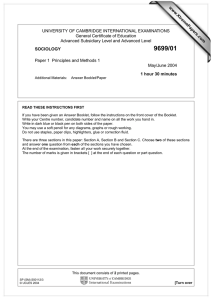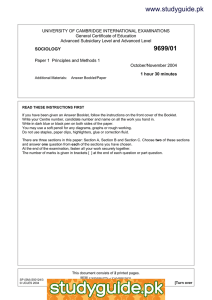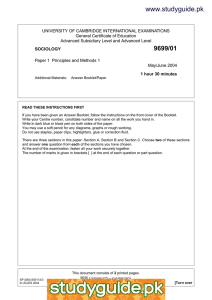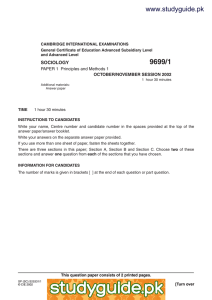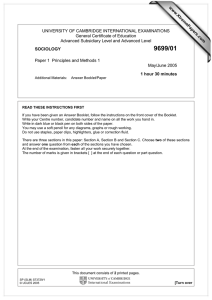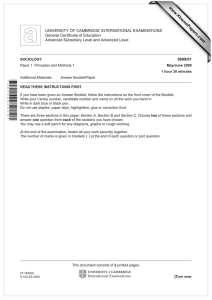9699 SOCIOLOGY MARK SCHEME for the May/June 2015 series
advertisement
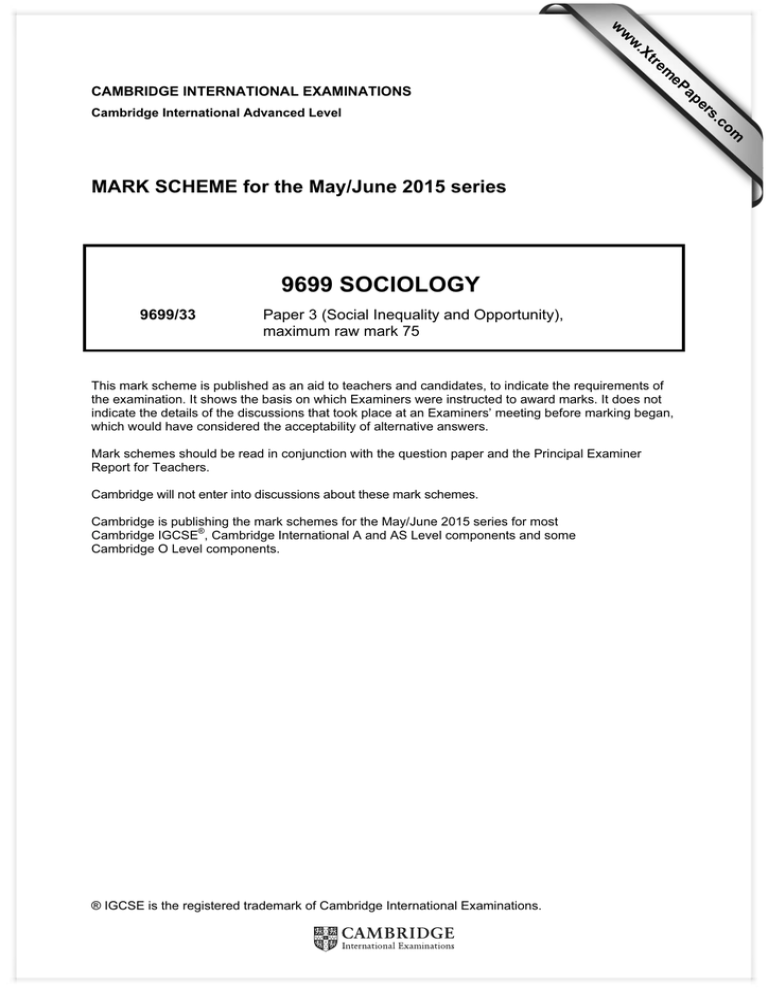
w w ap eP m e tr .X w CAMBRIDGE INTERNATIONAL EXAMINATIONS om .c s er Cambridge International Advanced Level MARK SCHEME for the May/June 2015 series 9699 SOCIOLOGY 9699/33 Paper 3 (Social Inequality and Opportunity), maximum raw mark 75 This mark scheme is published as an aid to teachers and candidates, to indicate the requirements of the examination. It shows the basis on which Examiners were instructed to award marks. It does not indicate the details of the discussions that took place at an Examiners’ meeting before marking began, which would have considered the acceptability of alternative answers. Mark schemes should be read in conjunction with the question paper and the Principal Examiner Report for Teachers. Cambridge will not enter into discussions about these mark schemes. Cambridge is publishing the mark schemes for the May/June 2015 series for most Cambridge IGCSE®, Cambridge International A and AS Level components and some Cambridge O Level components. ® IGCSE is the registered trademark of Cambridge International Examinations. Page 2 Mark Scheme Cambridge International A Level – May/June 2015 Syllabus 9699 Paper 33 Section A: Education 1 (a) Explain the functionalist view of the relationship between education and the wider society. [9] [0–4] At this level, there may be little or no reference to relevant sociological sources. Answers may rely on general knowledge and/or personal observation. Explanations will be brief and cover only a narrow range of relevant points. A few general observations about the role of education, with no direct links to functionalist theory, would be worth up to 3 marks. An answer that demonstrates a simple understanding of the functionalist theory of education would fit the top half of the band. A simple understanding may lack references to relevant concepts, ideas and thinkers. [5–9] At this level, there will be some use of relevant sociological sources, such as concepts, theories and explanations. Answers will cover a range of points and show a sound understanding of the issues raised by the question. Lower in the band, answers will provide a sound account of the functionalist theory of education. Better answers will demonstrate a more developed understanding of the functionalist view. It will include references to relevant concepts, such as value consensus and role allocation. The concept of meritocracy may also feature to good effect in well informed responses. (b) 'In schools today there is equality of opportunity between all pupils.' Assess this view. [16] [0–6] At this level, there may be little or no reference to relevant sociological sources. Answers may rely on general knowledge and/or personal observation. Explanations will be brief and cover only a narrow range of relevant points. An answer based on a few observations about equality of opportunity within society generally would be worth up to 3 marks. A discussion of the role of schools in society, with only limited links to the question, would trigger the upper part of the band. [7–11] Answers at this level will provide a sound account of the concept of equal opportunity in relation to schooling. A sound, but uncritical account of how schools may promote equality of opportunity between pupils would fit the lower part of the band. Better answers at this level will offer a more developed account; for example, this might include an attempt to unpack the concept of equality of opportunity and/or answers may consider obstacles to achieving equality of opportunity in schools. There may be little or no assessment at this level. [12–16] Answers that fit this band will demonstrate a good understanding of the idea that schools promote equality of opportunity. The problems that schools may face in promoting equality of opportunity will be considered. There will also be an assessment of the view on which the question is based. Lower in the band the assessment may be based on a juxtaposition of different theories of education, such as the functionalist and the Marxist views. Higher in the band the assessment will be more explicit and may include a critical analysis of the extent to which schools promote equality of opportunity between pupils. Use of relevant studies of schools may also be a feature of high quality answers. © Cambridge International Examinations 2015 Page 3 2 Mark Scheme Cambridge International A Level – May/June 2015 Syllabus 9699 Paper 33 (a) Explain how educational achievement may be affected by streaming. [9] [0–4] At this level, there may be little or no reference to relevant sociological sources. Answers may rely on general knowledge and/or personal observation. Explanations will be brief and cover only a narrow range of relevant points. A basic attempt to explain what is meant by streaming, with no links to the topic of educational achievement as such, would be worth up to 2 marks. Answers that lack references to sociological sources, but provide a few common sense observations about the links between streaming and educational achievement would fit the upper part of the band. [5–9] At this level, there will be some use of relevant sociological sources, such as concepts, theories and explanations. Answers will cover a range of points and show a sound understanding of the issues raised by the question. Lower in the band, answers may be confined to describing just one or two ways in which educational achievement may be influenced by streaming. The discussion at this level will be supported by references to appropriate sociological sources. To reach the top part of the band, the response must be more developed in terms of either the range of points covered or else in the depth of the sociological content used to explain the links between streaming and educational achievement. High quality answers might distinguish between the effects of streaming on different social groups (gender, class, ethnicity). (b) 'The main role of education systems is to maintain social control.' Assess this view. [16] [0–6] At this level, there may be little or no reference to relevant sociological sources. Answers may rely on general knowledge and/or personal observation. Explanations will be brief and cover only a narrow range of relevant points. An attempt to define the concept of social control, with no further links to the question, would fit the lower part of the band. Answers that are based on a few assertions about the role of education in general could score up to 6 marks. [7–11] Answers at this level will demonstrate a sound understanding of the idea that education systems work to maintain social control. This idea is often associated with Marxist and feminist theories of education. Lower in the band the answer may be limited to a basic account of the Marxist or feminist theory of education. Better answers at this level will offer more development; for example, at the top of the band there may be references to other roles performed by the education system, alongside the discussion of the social control function. Answers at this level may lack assessment and be wholly descriptive. [12–16] Answers that fit this band will demonstrate a good understanding of the role education systems play in the processes of social control. Contrasts may be made with other roles that have been attributed to education. There will also be an assessment of the view on which the question is based. Lower in the band the assessment may rely on a simple juxtaposition of different theories of education, such as the Marxist and functionalist views. To reach the top part of the band, the assessment must also include a more direct engagement with the debates about social control and education systems. Good answers may discuss the extent to which pupils are able to resist or overcome the social control functions of schools. It would also be relevant to consider the social construction of knowledge and its possible links with the ideological role of schools and colleges. © Cambridge International Examinations 2015 Page 4 Mark Scheme Cambridge International A Level – May/June 2015 Syllabus 9699 Paper 33 Section B: Global Development 3 (a) Explain why it might be difficult to distribute aid effectively in developing countries. [9] [0–4] At this level, there may be little or no reference to relevant sociological sources. Answers may rely on general knowledge and/or personal observation. Explanations will be brief and cover only a narrow range of relevant points. A few basic observations about development, with no direct links to issues involved in distributing aid effectively, would fit the lower part of the band. A simple account of one or two difficulties in distributing aid effectively, with little sociological underpinning, would trigger the top half of the band. [5–9] At this level, there will be some use of relevant sociological sources, such as concepts, theories and explanations. Answers will cover a range of points and show a sound understanding of the issues raised by the question. Lower in the band, answers will provide a sound sociological account of one or two problems of distributing aid effectively. Answers that merit the top half of the band will cover several relevant difficulties. The explanations offered will be clear and well developed. Obstacles in distributing aid effectively include: • Corruption among officials and local power brokers. • Problems arising from inadequate infrastructure. • Difficulty in responding quickly enough to sudden emergencies and major natural disasters. • Lack of knowledge of local cultures and traditions. • Lack of appropriate training among officials and volunteers. (b) ‘Government corruption is the main reason why the poor remain in poverty in many developing countries.’ Assess this view. [16] [0–6] At this level, there may be little or no reference to relevant sociological sources. Answers may rely on general knowledge and/or personal observation. Explanations will be brief and cover only a narrow range of relevant points. A few simple observations about the nature of poverty in developing countries, with no direct links to issues of government corruption, would fit the lower part of the band. Answers that are based on a few assertions about the links between corruption and poverty in the developing countries would trigger the top half of the band. [7–11] Answers at this level will provide a basic account of how government corruption may impede the process of reducing poverty in the developing countries. Lower in the band, government corruption may be the only factor that is discussed in explaining why poverty remains such a persistent problem in many developing countries. Better answers may also consider other explanatory factors, such as poor infrastructure, the impact of natural disasters, and lack of appropriate aid. Good answers at this level will include references to relevant theories and/or empirical evidence. For this band, there need be no attempt at assessment. © Cambridge International Examinations 2015 Page 5 Mark Scheme Cambridge International A Level – May/June 2015 Syllabus 9699 Paper 33 [12–16] Answers at this level will provide a good account of how government corruption might help to explain the high poverty levels in many developing countries. Other factors that are linked with the persistence of poverty will be considered. There will also be an assessment of the view on which the question is based. Lower in the band, the assessment may be limited to a basic attempt to show that government corruption is just one of several factors that impact on levels of poverty in developing countries. Better answers will provide a more developed assessment, with conclusions offered about the relative importance of government corruption as a factor explaining the persistence of poverty in developing countries. 4 (a) Explain the consequences for rural areas of a high level of rural-to-urban migration. [9] [0–4] At this level, there may be little or no reference to relevant sociological sources. Answers may rely on general knowledge and/or personal observation. Explanations will be brief and cover only a narrow range of relevant points. A simple attempt to define what is meant by rural-to-urban migration would be worth up to 2 marks. A tangential answer that discusses the causes rather than the consequences of ruralto-urban migration could gain no more than 2 marks. Answers that identify a few relevant consequences in a list-like way could gain up to 4 marks. [5–9] At this level, there will be some use of relevant sociological sources, such as concepts, theories and explanations. Answers will cover a range of points and show a sound understanding of the issues raised by the question. Answers at this level will discuss several consequences of rural-to-urban migration. Lower in the band the range of consequences considered may be narrow or the answer will lack detail. Better answers will cover a good range of consequences and the main points will be explained with reasonable development. The main consequences of rural-to-urban migration include: • Shortage of labour for agriculture. • An aging population in the rural area due to urban migration of younger age groups. • Breakdown of extended family networks. • Increased levels of poverty in rural areas due to loss of younger workers (although in some cases income may be returned to the rural areas by family members working in the cities, thereby helping to protect or improve the standard of living in the rural parts). • Cut backs in rural services. Note that the above is not an exhaustive list; other consequences can be rewarded. (b) Assess the impact of globalisation on local cultures. [16] [0–6] At this level, there may be little or no reference to relevant sociological sources. Answers may rely on general knowledge and/or personal observation. Explanations will be brief and cover only a narrow range of relevant points. A few simple points about local cultures, with no discussion of the impact of globalisation, would fit the lower part of the band. Answers that are based on assertion about the impact of globalisation would trigger the upper part of the band. © Cambridge International Examinations 2015 Page 6 Mark Scheme Cambridge International A Level – May/June 2015 Syllabus 9699 Paper 33 [7–11] Answers at this level will provide a basic sociological explanation of how globalisation may impact upon local cultures. Lower in the band, the discussion may be rather general and the points offered will be limited in range. Better answers within this band will discuss several ways in which globalisation may impact on local cultures. This might include discussion of media effects, consumerism and global branding, challenges to traditional belief systems, and the impact of economic modernisation. [12–16] Answers that fit this band will provide a good account of several ways in which globalisation might impact upon local cultures. The account will include references to relevant sociological concepts, theories and evidence. There will also be an assessment of the view on which the question is based. Lower in the band the assessment may be based on the juxtaposition of different perspectives on globalisation (for example, those perspectives that see globalisation primarily as a positive force and those that are critical of its impact on local cultures). Higher in the band, the assessment will engage more directly with the issues arising from the impact of globalisation on local cultures. Specific debates may be used as the basis for the assessment; for example, good use could be made of sociological accounts of the role of globalisation in the emergence of religious fundamentalism and/or movements for democratisation within some local cultures. © Cambridge International Examinations 2015 Page 7 Mark Scheme Cambridge International A Level – May/June 2015 Syllabus 9699 Paper 33 Section C: Media 5 (a) Explain the role of the media in creating moral panics. [9] [0–4] At this level, there may be little or no reference to relevant sociological sources. Answers may rely on general knowledge and/or personal observation. Explanations will be brief and cover only a narrow range of relevant points. A few observations about the role of the media in general, with no direct links to the question, would be worth up to 2 marks. Answers that attempt to explain what is meant by a moral panic, with no further development, could gain up to 4 marks. A simple attempt to explain the role of the media in creating moral panics, perhaps relying on assertions more than on recognisable sociological content, would trigger the top part of the band. [5–9] At this level, there will be some use of relevant sociological sources, such as concepts, theories and explanations. Answers will cover a range of points and show a sound understanding of the issues raised by the question. A basic account of the role of the media in creating moral panics would trigger the lower part of the band. Better answers will provide a more detailed account and/or cover a wider range of relevant content, including possibly references to Cohen’s original work on moral panics. Good use of concepts such as sensationalism, folk devils and labelling, may also be a feature of high scoring answers. (b) ‘The new media are now much more powerful than the traditional media’. Assess this view. [16] [0–6] At this level, there may be little or no reference to relevant sociological sources. Answers may rely on general knowledge and/or personal observation. Explanations will be brief and cover only a narrow range of relevant points. A few simple points about the power of the media in general would fit the lower part of the band. Answers that set out the main differences between the new media and the traditional media, with no further development in relation to the question, would trigger the higher part of the band. [7–11] Answers at this level will provide a basic account of the differences between the two types of media and how that impacts upon the ability of the new media and the traditional media to exercise power in society. Lower in the band the account may lack detail. Better answers will offer a more sustained account of the possible differences in power between the two media. Issues that might be covered include the following: • Differences in consumption patterns in relation to the two types of media, including the growing take-up of new media means of entertainment and communication. • Reflections on the power of each type of media in different areas of society, including politics, cultural expression, social influence, and consumer choices. • Examples of how the new media may be used to enhance the power of particular individuals and groups, and contrasts with the traditional media. • Analysis of how the power of the traditional media may have been diluted by the emergence of the new media. At this level there may be little or no assessment of the view on which the question is based. © Cambridge International Examinations 2015 Page 8 Mark Scheme Cambridge International A Level – May/June 2015 Syllabus 9699 Paper 33 [12–16] Answers at this level will provide a good account of the differences between the new media and the traditional media, and the relevance of those differences for understanding the distribution of power within the media today. There will also be an assessment of the view on which the question is based. Lower in the band the assessment may be limited to the juxtaposition of different theories of media influence applied to the distinction between the new media and the traditional media. Better answers at this level will also include some direct engagement with the issues raised by the question. This might be based on, for example, an analysis of the extent to which the power of the traditional media has been surpassed by the power of the new media. Good answers might also question which groups benefit most from the new media in terms of access to power, and relevant contrasts may be drawn with the traditional media. High-quality answers might also draw on examples of particular uses of the new media to illustrate wider points about the power of the media today. 6 (a) Explain how decisions are made within the media about what is newsworthy. [9] [0–4] At this level, there may be little or no reference to relevant sociological sources. Answers may rely on general knowledge and/or personal observation. Explanations will be brief and cover only a narrow range of relevant points. A few general observations about the role of the media, with no direct links to the question, would fit the lower part of the band. Some basic points about how decisions are made within the media, with little or no reference to the social construction of the news, would be worth 2 or 3 marks. A few simple points about how the media decide what is newsworthy, with little sociological underpinning, could gain up to 4 marks. [5–9] At this level, there will be some use of relevant sociological sources, such as concepts, theories and explanations. Answers will cover a range of points and show a sound understanding of the issues raised by the question. Answers at this level will provide a sound sociological account of how decisions are made in the media about what is newsworthy. Lower in the band the range of points covered may be narrow and/or the points may lack development. Better answers will cover several points about how the media decides what is newsworthy and the points will be well supported with references to relevant sociological content such as use of concepts and/or references to research evidence and theories. Highquality answers may distinguish between different media and explain how these differences affect the presentation of news (for example, differences between the news as presented in the tabloid press and the news in the tradition of the broadsheet newspaper). (b) ‘There are many theories of how the media affects human behaviour, but all have limitations’. Assess this view. [16] [0–6] At this level, there may be little or no reference to relevant sociological sources. Answers may rely on general knowledge and/or personal observation. Explanations will be brief and cover only a narrow range of relevant points. A few general points about the influence of the media, with no direct links to the question, could score up to 3 marks. A limited attempt to explain one theory of how the media affects human behaviour, with no further development, would trigger the upper part of the band. Theories of how the media affects human behaviour include the hypodermic-syringe model, the uses and gratification model, the audience effects model. An attempt to explain how the media affects human behaviour, with no reference to the recognisable sociological theories, could gain no more than 6 marks. © Cambridge International Examinations 2015 Page 9 Mark Scheme Cambridge International A Level – May/June 2015 Syllabus 9699 Paper 33 [7–11] Answers at this level will provide a basic account of at least one theory of how the media affects human behaviour. Lower in the band the answer may be limited to explaining just one theory or several theories may be explained in a rather list-like way. Better answers at this level will explain two or more relevant theories in reasonable detail. References to relevant research studies would be one way of adding appropriate detail to the answer. There may be little or no evidence of assessment in answers that fit this band. [12–16] Answers at this level will provide a good account of two or more theories of how the media affects human behaviour. There will also be an assessment of the view on which the question is based. Lower in the band the assessment may be confined to a few basic points about the limitations of some or all of the theories under discussion. Better answers will provide a more sustained assessment, demonstrating subtlety in the analysis and reaching clear conclusions about the extent to which the different theories of media influence all have limitations. © Cambridge International Examinations 2015 Page 10 Mark Scheme Cambridge International A Level – May/June 2015 Syllabus 9699 Paper 33 Section D: Religion 7 (a) Explain why New Age ideas are replacing traditional belief systems in some societies. [9] [0–4] At this level, there may be little or no reference to relevant sociological sources. Answers may rely on general knowledge and/or personal observation. Explanations will be brief and cover only a narrow range of relevant points. A few observations about the nature of belief systems in general, with no direct links to the question, would fit the lower half of the band. Answers that describe New Age ideas without explaining their popularity could gain up to 2 marks. A simple account of one factor that may have led to the growth of New Age ideas would reach the top half of the band. [5–9] At this level, there will be some use of relevant sociological sources, such as concepts, theories and explanations. Answers will cover a range of points and show a sound understanding of the issues raised by the question. A sound account of one or two factors that may have led to the growth of New Age ideas would trigger the lower part of the band. To go higher, the account must be more detailed or wider-ranging in the factors covered. Factors that may have led to the growth of New Age ideas include: • Disillusionment with scientific ways of understanding. • Breakdown of traditional belief systems. • Search for a synthesis of ideas from different traditions. • Impact of consumerism on modes of expression and belief. (b) ‘Religion has little influence on human behaviour today’. Assess this view. [16] [0–6] At this level, there may be little or no reference to relevant sociological sources. Answers may rely on general knowledge and/or personal observation. Explanations will be brief and cover only a narrow range of relevant points. A few assertions about the nature or role of religion, without direct links to the question, would fit the lower part of the band. An outline of some general ways in which religion may influence human behaviour, with no further development, would merit a mark in the top half of the band. [7–11] Answers at this level will provide a sound account of the influence of religion on human behaviour. Lower in the band, the answer may be confined to a basic account of the secularisation thesis that is somewhat lacking in detail. To go higher, there would need to be a more developed treatment of the secularisation debate, with different indicators of secularisation perhaps documented. The discussion might include, for example, references to church attendance figures, church membership, public influence of established religious organisations, and studies of religious belief. However, the discussion at this level may be one-sided and lacking an assessment of the idea that religious influence is in decline in modern industrial societies. © Cambridge International Examinations 2015 Page 11 Mark Scheme Cambridge International A Level – May/June 2015 Syllabus 9699 Paper 33 [12–16] Answers at this level will demonstrate a good understanding of the secularisation thesis and the view that religion is becoming a less powerful influence on human behaviour. There must also be an assessment of the view on which the question is based. Lower in the band, the assessment may consist of simply describing the different arguments for and against the secularisation thesis. Better answers will engage more directly with the debates and develop well-reasoned arguments for supporting a particular view about the influence of religion in society today. High-quality answers may also show other elements of sophistication, such as distinguishing between different types of secularisation (Casanova), or drawing international comparisons about the degree of secularisation in different countries (Martin, Davie, Bruce), or discussing the notion of religious revival (Kepel), or questioning how powerful religion was as an influence on human behaviour in the past. 8 (a) Explain the feminist view that patriarchy is a feature of many religious organisations. [9] [0–4] At this level, there may be little or no reference to relevant sociological sources. Answers may rely on general knowledge and/or personal observation. Explanations will be brief and cover only a narrow range of relevant points. Some simple points about religious organisations in general, with few direct links to the question, would fit the lower part of the band. A few assertions about the positions of women within religious organisations, with no reference to feminist theory, could gain up to 3 marks. Better answers at this level may offer a basic account of the feminist theory of religion, but with no direct references to the concept of patriarchy. [5–9] At this level, there will be some use of relevant sociological sources, such as concepts, theories and explanations. Answers will cover a range of points and show a sound understanding of the issues raised by the question. A basic account of the feminist theory of religion, with some reference to patriarchy, would merit a mark in the lower half of the band. To go higher, the answer must show a stronger understanding of the underlying ideas and provide a more sustained account of the links between gender and hierarchy in religious organisations. Good answers may cite evidence of patriarchy in religious organisations and/or refer to different feminist contributions to the relevant debates. © Cambridge International Examinations 2015 Page 12 Mark Scheme Cambridge International A Level – May/June 2015 Syllabus 9699 Paper 33 (b) ‘With the transition from modernity to post-modernity, religion has become just one of many belief systems that people may choose to follow’. Assess this view. [16] [0–6] At this level, there may be little or no reference to relevant sociological sources. Answers may rely on general knowledge and/or personal observation. Explanations will be brief and cover only a narrow range of relevant points. A few simple assertions about the impact of modernity on cultures or belief systems would be worth up to 3 marks. A basic outline of what is meant by the transition from modernity to post-modernity, with no further links to the question, would trigger the higher part of the band. [7–11] Answers at this level will provide a sound account of the relationship between religion and other belief systems today. An answer that offers a simple account of how the move to postmodernity may have impacted upon choice of belief systems, could gain up to 9 marks. To go higher, the explanation must be more detailed and demonstrate a fuller understanding of the idea that religion has becomes just one of many belief systems that people may choose to follow today. The ideas of thinkers such as Bayer, Huntington, Bauman, Giddens and Beckford, would be particularly relevant in answering the question. To reach the top of this band, it is not essential to provide an assessment of the view on which the question is based. [12–16] Answers at this level will provide a good account of the possible links between the transition from modernity to post-modernity and the supposed fragmentation in the range of belief systems that people may choose to follow. There will also be an attempt to assess the view on which the question is based. Lower in the band the assessment may be through the simple juxtaposition of arguments for and against the notion that religious influence is declining. Higher in the band the assessment will engage directly with the issues raised by the question and clear conclusions will be reached about the extent to which religion has become just one of many belief systems that people may choose to follow, and whether this may be explained in terms of the transition from modernity to post-modernity. Good use of post-modernist contributions to the relevant debates may be a feature of answers that merit the top part of the band. High-quality answers may also question the extent to which religion was the dominant belief system for people in the past. © Cambridge International Examinations 2015
